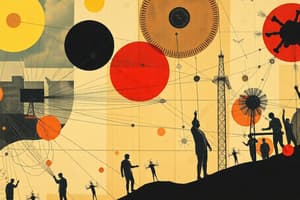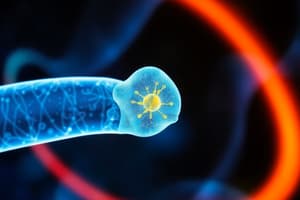Podcast
Questions and Answers
What is the primary purpose of a control system?
What is the primary purpose of a control system?
- To independently operate without any input
- To manage, command, and regulate the behavior of other systems (correct)
- To disconnect components from one another
- To only measure input and output without any modifications
What is defined as the controlled variable in a control system?
What is defined as the controlled variable in a control system?
- The overall system configuration used for control
- The deviation value between input and output
- The intended output that is measured and regulated (correct)
- The input that is changed to drive the process
Which of the following best describes the manipulated variable?
Which of the following best describes the manipulated variable?
- The error rate of the control system
- The unchanging value set for the controlled variable
- The condition that influences the output of the process (correct)
- The measured value of the controlled variable
What constitutes the input and output relationship in a control system?
What constitutes the input and output relationship in a control system?
When control is performed in a control system, what does it involve?
When control is performed in a control system, what does it involve?
What is a primary characteristic of Open-Loop Control Systems?
What is a primary characteristic of Open-Loop Control Systems?
Which of the following is an example of a Manual Control System?
Which of the following is an example of a Manual Control System?
What component is NOT part of a typical Anti-lock Braking System (ABS)?
What component is NOT part of a typical Anti-lock Braking System (ABS)?
Which type of control system is characterized by inputs that are not compared to outputs?
Which type of control system is characterized by inputs that are not compared to outputs?
What is a feature of Closed-Loop Control Systems?
What is a feature of Closed-Loop Control Systems?
Which system primarily absorbs energy from road bumps to ensure a smooth vehicle ride?
Which system primarily absorbs energy from road bumps to ensure a smooth vehicle ride?
Which of the following best describes Automatic Control Systems?
Which of the following best describes Automatic Control Systems?
In terms of calibration, how do Open-Loop Control Systems function?
In terms of calibration, how do Open-Loop Control Systems function?
What is a major disadvantage of an open-loop system?
What is a major disadvantage of an open-loop system?
Which of the following is an advantage of closed-loop control systems?
Which of the following is an advantage of closed-loop control systems?
Which system is most likely to be described as a closed-loop control system?
Which system is most likely to be described as a closed-loop control system?
What is the primary function of feedback in a feedback control system?
What is the primary function of feedback in a feedback control system?
How can transient response and steady-state error be managed in a closed-loop system?
How can transient response and steady-state error be managed in a closed-loop system?
What impact do disturbances have on open-loop systems?
What impact do disturbances have on open-loop systems?
Which type of feedback results in enhancing the output of a system?
Which type of feedback results in enhancing the output of a system?
What role does a comparator play in a closed-loop system?
What role does a comparator play in a closed-loop system?
What is the primary disadvantage of a closed-loop system?
What is the primary disadvantage of a closed-loop system?
Which factor is NOT typically considered when choosing between an open-loop and a closed-loop system?
Which factor is NOT typically considered when choosing between an open-loop and a closed-loop system?
What is a defining characteristic of a servo system?
What is a defining characteristic of a servo system?
Which type of control systems can be classified based on the aspect of manual versus automatic?
Which type of control systems can be classified based on the aspect of manual versus automatic?
What is a common example of an open-loop control system?
What is a common example of an open-loop control system?
Which of the following best describes the difference between linear and non-linear control systems?
Which of the following best describes the difference between linear and non-linear control systems?
What is a key reason for implementing a closed-loop system instead of an open-loop system?
What is a key reason for implementing a closed-loop system instead of an open-loop system?
What type of feedback does a servo system provide?
What type of feedback does a servo system provide?
Flashcards are hidden until you start studying
Study Notes
What is a Control System?
- A control system manages, commands, directs, or regulates the behavior of other devices/systems.
Definitions
- System: A group of interconnected elements and devices for a particular purpose.
- Control System: A system of interconnected components for a desired response.
- Process: The device, plant, or system being controlled.
- Controlled Variable: The quantity or condition measured and regulated. Usually the output of the control system.
- Manipulated Variable: The quantity or condition changed by the controller to affect the controlled variable.
Examples of Control Systems
- Car Cruise Control: Uses a feedback loop to maintain a constant speed.
- Anti-lock Braking System (ABS): Regulates braking force to prevent wheel lock-up.
- Vehicle Suspension System: Absorbs the energy of bumps in the road to maintain a smooth ride.
Types of Control Systems
- Natural Control Systems: Examples include the universe and the human body.
- Man-made Control Systems: Examples include vehicles and aeroplanes.
- Manual Control Systems: Examples include room temperature regulation with an electric fan and water level control.
- Automatic Control Systems: Examples include room temperature regulation with an air conditioner and human body temperature control.
Open-Loop Control Systems
- Use a controller to achieve the desired response, but the output has no effect on the control action.
- The output is not measured or fed back to the control system.
- Examples include washing machines, toasters, and electric fans.
- The accuracy of the system depends on calibration and is sensitive to disturbances.
Closed-Loop Control Systems
- Use feedback to compare the actual output to the desired output response.
- The output is measured and compared to the desired input.
- The difference between the measured value and the desired value is used to adjust the control action.
- Examples include a refrigerator and an iron.
Feedback Control Systems
- Use feedback to maintain a desired relationship between the output and reference input.
- The difference between the measured output and the desired input is used as a means of control.
- Feedback can be positive or negative.
Open-Loop vs. Closed-Loop Systems
- Factors for choosing between open-loop and closed-loop: Criticality of the application, the need to monitor and control the output, error tolerance, cost, safety.
Multivariable Control System
- Multiple controlled variables and manipulated variables.
- Examples include systems that control temperature, humidity, and pressure simultaneously.
Servo System
- A feedback control system where the output is a mechanical position, velocity, or acceleration.
- Examples include antenna positioning systems and modular servo systems.
Classification of Control Systems
- Control Systems can be classified as: Natural, man-made, manual, automatic, open-loop, closed-loop, linear, non-linear, time-invariant, or time-variant.
Studying That Suits You
Use AI to generate personalized quizzes and flashcards to suit your learning preferences.




